Related Research Articles

Andrew Marvell was an English metaphysical poet, satirist and politician who sat in the House of Commons at various times between 1659 and 1678. During the Commonwealth period he was a colleague and friend of John Milton. His poems range from the love-song "To His Coy Mistress", to evocations of an aristocratic country house and garden in "Upon Appleton House" and "The Garden", the political address "An Horatian Ode upon Cromwell's Return from Ireland", and the later personal and political satires "Flecknoe" and "The Character of Holland".

John Tillotson was the Anglican Archbishop of Canterbury from 1691 to 1694.

James Wyatt was an English architect, a rival of Robert Adam in the neoclassical and neo-Gothic styles. He was elected to the Royal Academy in 1785 and was its president from 1805 to 1806.
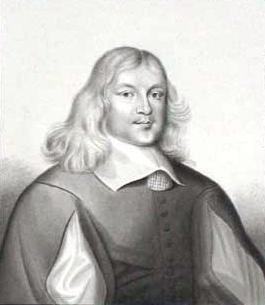
John Bradshaw was an English jurist. He is most notable for his role as President of the High Court of Justice for the trial of King Charles I and as the first Lord President of the Council of State of the English Commonwealth.

Thorncombe is a village and civil parish now in the English county of Dorset but historically until 1844 in Devon. It lies five miles (8 km) south east of the town of Chard in neighbouring Somerset. Thorncombe is situated close to the borders of both Somerset and Devon. In the 2011 census the population of the civil parish was 687.
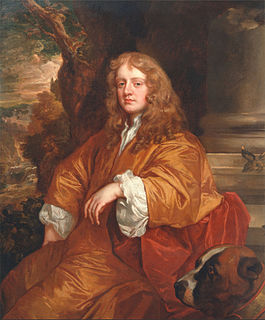
Sir Ralph Bankes (1631–1677) was a courtier of the restored Charles II and a knighted member of the Privy Chamber. He was the builder of Kingston Lacy, the restored seat of the Bankes family, designed by architect Sir Roger Pratt.
Rev. John Wesley (1636–78) was an English nonconformist minister. He was the grandfather of John Wesley.
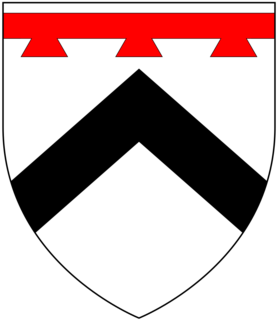
Edmund Prideaux of Forde Abbey, Thorncombe, Devon, was an English lawyer and Member of Parliament, who supported the Parliamentary cause during the Civil War. He was briefly solicitor-general but chose to resign rather than participate in the regicide of King Charles I. Afterwards, he was attorney-general, a position he held until he died. During the Civil War and for most of the First Commonwealth he ran the postal service for Parliament.
Sir Henry Rosewell (1590–1656) of Forde Abbey, Devon, was a puritan and supporter of the New World colonies.
William Dugard, or Du Gard, was an English schoolmaster and printer. During the English Interregnum, he printed many important documents and propaganda, first in support of Charles I and later of Oliver Cromwell. He also proved a successful master at a number of schools, including the Merchant Taylor's School, Colchester Royal Grammar School and Stamford School, and wrote a number of non-fiction works.
Richard Michael Townsend Tyler was an English architect who was notable for his restoration work on large private houses after the Second World War, which allowed families to own more manageable homes while remaining sympathetic to their original designs.

Oliver Cromwell's head is the head of Oliver Cromwell. The man became Lord Protector and ruler of the English Commonwealth after the defeat and beheading of King Charles I during the English Civil War. Cromwell died on 3 September 1658 of natural causes and was given a public funeral at Westminster Abbey equal to those of the monarchs who came before him. His position passed to his son Richard, who was overthrown shortly after, leading to the re-establishment of the monarchy.

Forde Abbey is a privately owned former Cistercian monastery in Dorset, England, with a postal address in Chard, Somerset. The house and gardens are run as a tourist attraction while the 1,600-acre (650 ha) estate is farmed to provide additional revenue. Forde Abbey is a Grade I listed building.

The Prideaux Baronetcy, of Netherton in the County of Devon, was a title in the Baronetage of England. It was created on 17 July 1622 for Edmund Prideaux. The third Baronet sat as Member of Parliament for Liskeard and St Mawes. The fourth Baronet was Member of Parliament for Tregony. The title became extinct on the death of the ninth Baronet in 1875.
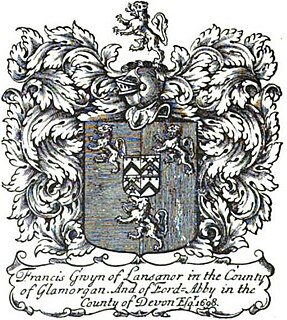
Francis Gwyn PC, of Llansannor Court, was a Welsh Tory politician who sat in the English and House of Commons at various times between 1673 and 1727.
Edmund Prideaux (1634–1702) was a member of Parliament for the constituency of Taunton. He took part in Monmouth's rebellion, and bribed Judge Jeffreys heavily to save his life.

Sir Edmund Prideaux, 1st Baronet (1554–1628), of Netherton in the parish of Farway, Devon, was a Councellor at Law and Double Reader of the Inner Temple and was created a baronet on 17 July 1622. He purchased the estate of Netherton where in 1607 he built a new mansion house, known today as Netherton Hall, a grade II listed building. He was one of John Prince's Worthies of Devon.
During the Protectorate period (1653–1659) of the Commonwealth of England, the Lord Protector reserved the power previously held by the monarch to confer knighthoods, baronetcies and peerages.
William Hooke or Hook (1600–1677) was an English Puritan clergyman, in New England for nearly two decades, mostly at New Haven.
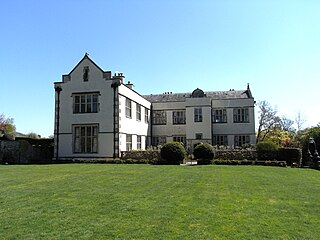
Netherton in the parish of Farway in Devon is an historic estate situated about 3 1/2 miles south-east of Honiton. The present mansion house known as Netherton Hall was built in 1607 in the Jacobean style, restored and rebuilt 1836-44, and is a Grade II listed building.
References
- ↑ John Cornforth, 'Forde Abbey, Dorset, III', Country Life, 133 (1963).
- ↑ Tim Mowl & Brian Earnshaw, Architecture Without Kings: The Rise of Puritan Classicism Under Cromwell (Manchester, 2015), pp. 111-6.
- Colvin, Howard. A Biographical Dictionary of British Architects, 1600-1840. Yale University Press, 3rd edition, 1995.